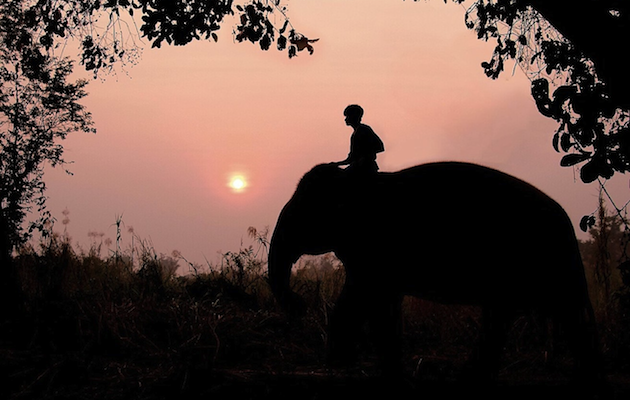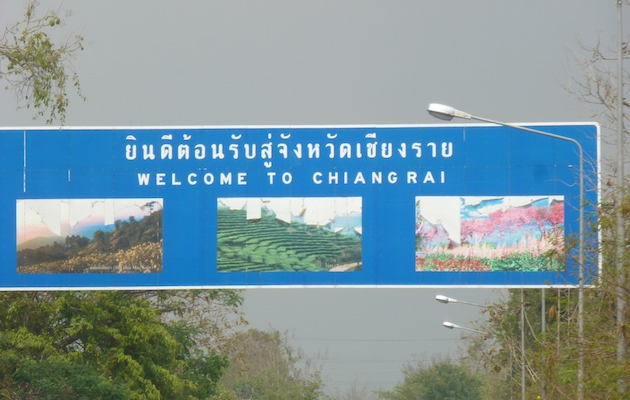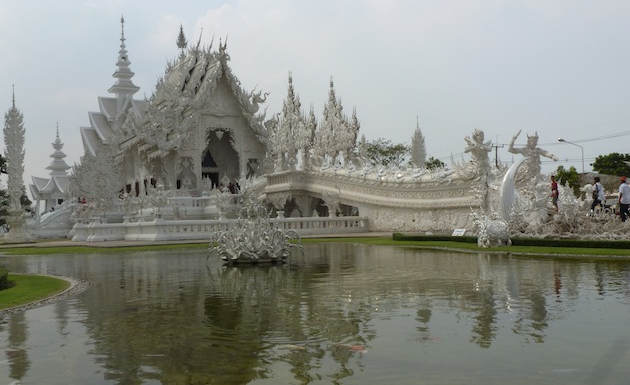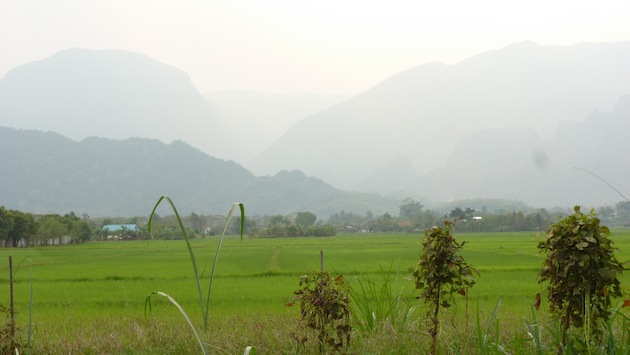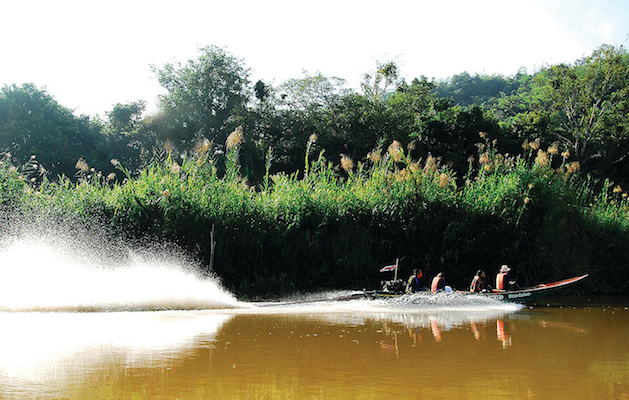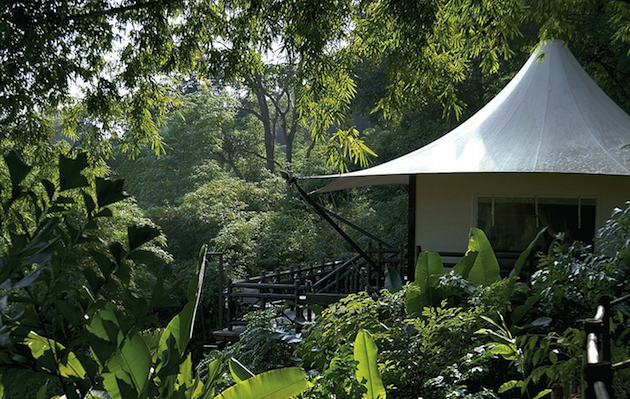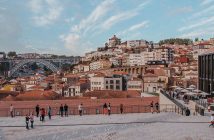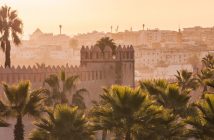I have arrived in the most extraordinary place. As I write I am sat in a wooden treetop bar, in comfortable surroundings, a reed canopy overhead, straining to write against candlelight, the distant hills of Burma sporadically illuminated by streaks of lightning and backed by a growl of thunder moments later. Were it not for the ambient music working in time with the hum of the jungle, I would imagine myself deep in isolated wilderness. Save the roof overhead, we are exposed to the elements, the air is muggy without being oppressive, the evening temperature balmy without being off-putting. It is, in a word, glorious.
The journey here began a mere three days ago, via a thoroughly pleasant two nights in Chiang Mai for an immersive experience in Thai cuisine, and then a four-hour drive north via Chiang Rai to the Burmese border.
Marked as a main road on the map, the route between Chiangs Mai and Rai is, for the most part, a single lane following the natural gradient of interlocking hillsides, that is until one hits the Chiang Rai state line whereupon it opens up into dual carriageway on a broad valley plain, with rice fields either side stretching out to the temple-capped hills in the distance. Here, too, one passes through towns, such as Wing Pa Pao, with almost every inch of roadside given over to trade. I say ‘towns’ but it seemed the main stretch of road, straight as a die for the most part, was continually populated making this one of the longest high streets I think I’ve seen outside Canada.
It was during one pit-stop, at a pie shop of all places, that I began to see the first signs of ‘The Golden Triangle’ tourist trail; maps and memorabilia for sale, and a Burmese army trekking stick attributed to, and with a short bio of, Sir Jeffrey Hillpig-Smyth, its inventor. This Xanadu-sounding destination, our final stop, is so named for it being the confluence of three countries; Thailand, Burma and Laos, each bordering the Mekong River and its tributaries. And there, right in its heart, lay my destination.
Twenty minutes on, and on the outskirts of Chiang Rai, our next note-worthy stop, the temple of Wat Rong Khun. Almost entirely white, designed to indescribable detail and flecked with thousands of mosaic pieces of mirrored glass, it no doubt dazzles in the sunlight. Today, however, it was overcast, but no less impressive, though I’m not sure a rendering of ‘Predator’ in the grounds was part of the original plans. No less morbid are the multitude of hands reaching up from the ground as one steps onto the walkway to the main temple.
We drove on, through Chiang Rai itself and out again when, once more, built-up urban bustle gave way to single lane A-road. Only now the rice fields reappeared but the mountains beyond had evolved. Undulating hills had become steep-sided crags, blue and grey through what I thought must be mist. Tolkein would have had a field day. These are the Smokey Mountains, my driver told me, so named because of the logging and burning by the farmers of nearby Pong Pha.
A little further, and just before Mae Sai, Thailand’s northernmost point, we turned off the main road and headed east. Amid the lush green padi fields and misty grey mountains I saw, rather incongruously, lines of uniform housing; like collectives in contrast to what otherwise made for attractive and unoppressed landscape. A-road became B-road became dirt track – this really was turning into an adventure – from which, a little further on, we abandoned the car entirely to be met by a waiting stewardess, who put me in a lifejacket and ushered me into a long tail boat. We were on the very edge of the country in a narrow tributary of the Mekong, the Ruak. And almost within touching distance was Burma.
We bolted off in this craft, slicing through the muddy water to what I could see on a hillside we were heading for some half a mile away were tent canopies I could just make out amid foliage; our destination. We shot past them, circling the hillside, my guide pointing out each feature of the camp as we went, before we came to a clearing where two elephants bathed in the water by a jetty, our point of disembarkation. A few steps up to a platform I was invited to toll a gong three times – for health, wealth and a long life – and with a harrumph from the nearby pachyderms, I had arrived. This journey, and the preamble you’re reading, are a necessary build-up to what it is, simply, the extraordinary Four Seasons’ Tented Camp.
The camp comprises fifteen ‘tents’ nestled into the hillside of a bamboo forest, making up part of a 200 acre estate on the banks of the Ruak. Further buildings include the restaurant, terrace and a pool at one end and, at the other, along a narrow path off which the tents are sited, the ‘Burma Bar’, Traders’ Post and elephant sanctuary.
I say ‘tents’ in the loosest sense of the word, for these are self-contained units of unbridled luxury that would outstrip anything that ghastly monicker ‘glamping’ could ever offer. Having been met with a refreshing lemongrass and honey cocktail and cooling flannel on arrival, I was introduced to my home for the next two days; sure, there were canvas sides and plastic windows but, inside, polished teak floors, temperature control, ceiling fans, en suite loo, outdoor shower (with views of the river valley below), a huge roll top bath, kingsize bed as comfortable as a cloud and a mosquito net canopy, a desk fitted with lamps – electricity throughout, needless to say – two basins complete with ‘horns’ for hot and cold water, fridge and mini-bar complete with freshly ground coffee and cafetiere, not to mention a variety of little touches of comfort. The decor centred around the tent’s name, The Butterfly Tent, and displayed cases featuring many types of indigenous butterfly and beetle species – others, I understand, were suitably appointed; Hilltribe Tent, Birdwatcher’s Tent et al. To cap it all, the whole river-facing side was essentially one large window, opening out to a balcony that stretched the length of the canopy and looked out to the grounds where the elephants grazed by the river, the Burmese jungle and hills beyond. Two days would never be enough.
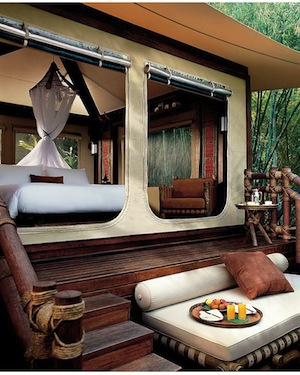 Once refreshed, I set off through camp – crossing a rope suspension bridge over a gully and passing my neighbours’ abodes – I noticed there was even an Opium Tent (themed in decor, I presumed, rather than offering narcotic sustenance) – to the Burma Bar. Here, amid the colonial apparel, the Duty Manager, Vikas, furnished me with details about the camp, the culture of northern Thailand and test cricket over a lemongrass martini. The most significant takeaway was the nature of the service the camp had to offer; there being only fifteen tents and no more than thirty guests at one time, it’s very personalised. But, more than that, they make a concerted effort to ‘read’ guests’ needs; noting those wishing to be sociable or those preferring, say, a quiet corner in the restaurant.
Once refreshed, I set off through camp – crossing a rope suspension bridge over a gully and passing my neighbours’ abodes – I noticed there was even an Opium Tent (themed in decor, I presumed, rather than offering narcotic sustenance) – to the Burma Bar. Here, amid the colonial apparel, the Duty Manager, Vikas, furnished me with details about the camp, the culture of northern Thailand and test cricket over a lemongrass martini. The most significant takeaway was the nature of the service the camp had to offer; there being only fifteen tents and no more than thirty guests at one time, it’s very personalised. But, more than that, they make a concerted effort to ‘read’ guests’ needs; noting those wishing to be sociable or those preferring, say, a quiet corner in the restaurant.
Continues on page 2…

